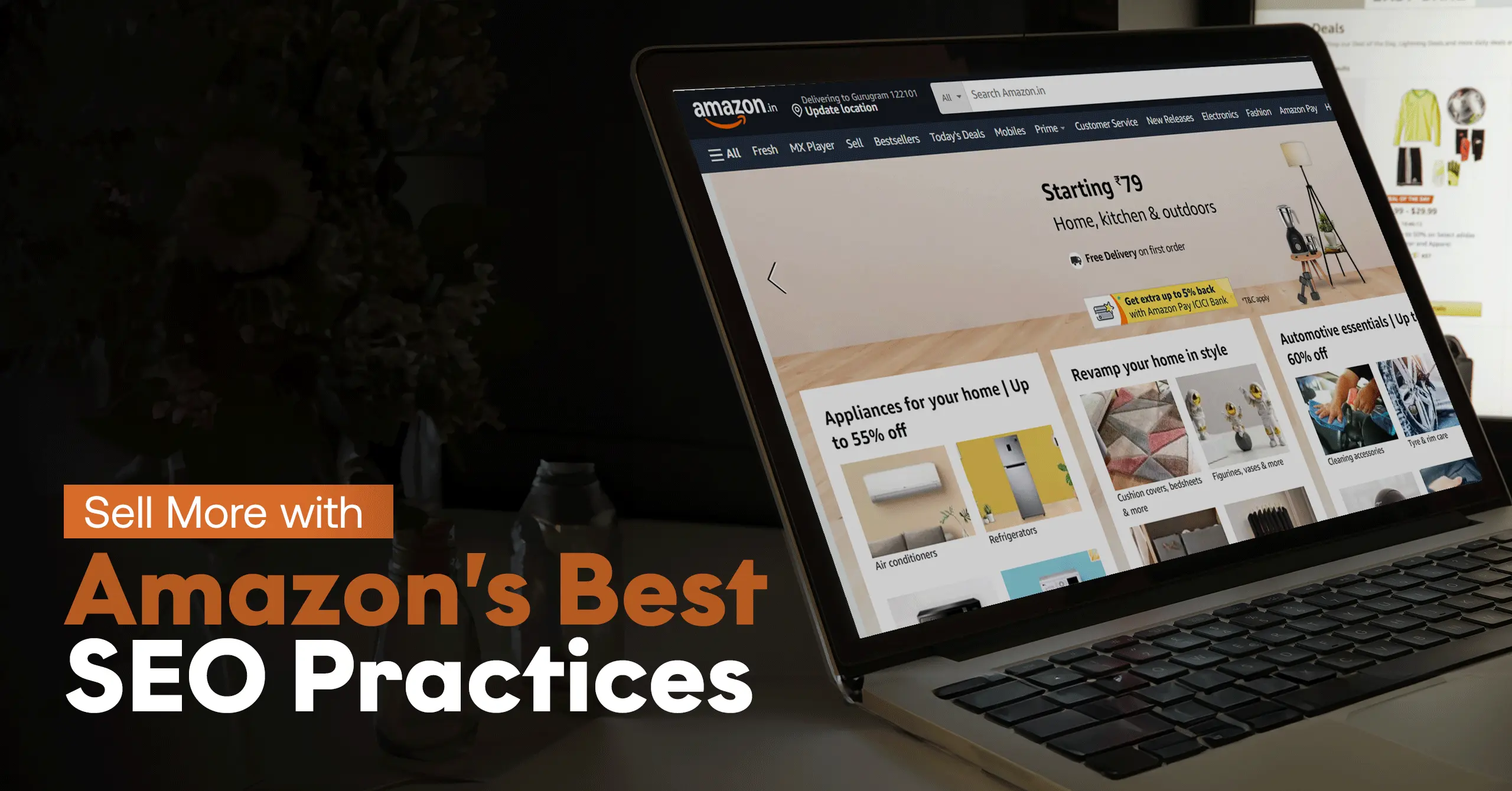Amazon SEO Strategy: Elevate Rankings and Sales with Proven Tactics

Listing a product on Amazon is just the starting point. With over 9.7 million sellers competing for attention, standing out takes more than simply going live. A well-planned Amazon SEO strategy is key to boosting visibility, attracting the right shoppers, and driving steady sales.
Optimizing your product titles, descriptions, images, and backend keywords can make a real difference in how your listings rank. These on-page updates are often the difference between being seen—or completely overlooked.
For e-commerce sellers and digital marketers, getting these strategies right means more visibility, more trust, and more growth. This Amazon SEO guide walks you through the essential techniques to rank higher, grab attention, and succeed in a crowded marketplace.
Understanding Amazon SEO: How It Works
Ever wondered how some products on Amazon seem to appear right at the top while others get lost in the crowd? That is where Amazon SEO comes in:
What is Amazon SEO, and Why is it Important?
Amazon SEO strategy involves optimizing product listings to rank higher in Amazon’s search results. With over 56% of online shoppers beginning their searches on Amazon, visibility directly influences sales. Unlike traditional search engines, Amazon’s ranking algorithm prioritizes product relevance, performance, and conversion rates to ensure customers find the most suitable products.
SEO for Amazon marketplace aims to position a product among the top search results when buyers look for relevant keywords. A well-optimized product listing increases discoverability, leading to higher sales and better rankings. Since competition is intense, sellers must constantly refine their approach to stay ahead.
How Does the A9 Algorithm Determine Rankings?
The A9 algorithm prioritizes products that generate sales because Amazon’s ultimate goal is to maximize revenue. Here is the SEO checklist for Amazon:
- Relevance: Keyword placement in titles, bullet points, descriptions, and backend search terms affects discoverability. Products that closely match search queries are more likely to rank higher.
- Performance Metrics: Sales velocity, customer reviews, and feedback influence rankings. A higher number of positive reviews signals product reliability and desirability.
- Conversion Rates: The likelihood of a customer purchasing after viewing a listing determines ranking strength. The algorithm favors SEO-optimized Amazon product listings with high conversion rates.
Optimising Product Listings for Maximum Visibility
Enhancing your product listings with the best SEO practices for Amazon is essential for increasing visibility, drawing in more buyers, and driving sales.
Keyword Research: Identifying High-impact Search Terms
An effective Amazon SEO strategy starts with thorough keyword research. Identifying the right search terms ensures products appear before the right audience. Tools like Amazon Auto-Suggest, Helium 10, Jungle Scout, and MerchantWords help discover high-impact keywords.
Long-tail keywords are particularly valuable as they target specific buyer intent and face less competition. Strategically placing keywords in titles, bullet points, descriptions, and backend search terms maximizes visibility.
A well-researched keyword strategy also involves analyzing competitor listings. Identifying the keywords that top-ranking competitors use can provide insights into what works best for a specific product category.
Helium 10
Jungle Scout
Crafting the Perfect Product Title
A well-optimized title improves product discoverability. It should be concise yet informative, incorporating primary keywords while remaining easy to read. Although Amazon allows up to 200 characters, keeping it under 80 characters enhances mobile visibility.
A strong title should include:
- Brand name
- Product type
- Key feature(s)
- Size or color
- Avoid excessive keyword stuffing, as it compromises readability and deters potential buyers.
Writing High-converting Bullet Points
Bullet points are crucial for persuading customers. They should highlight unique features and benefits in a clear, scannable format. Rather than listing technical specifications, bullet points should address common customer pain points and illustrate how the product solves them.
Each bullet point should focus on a different aspect of the product, such as durability, ease of use, or standout features. Keeping them concise ensures maximum impact.
To increase effectiveness, bullet points should include action-driven language, such as “enhances comfort,” “improves efficiency,” or “saves time.” This approach helps customers understand how the product benefits them.
Creating a Persuasive Product Description
A compelling product description enhances conversions by providing a detailed yet engaging overview. Formatting using bold headers, bullet points, and line breaks makes content easier to read.
Storytelling can be an effective approach. Instead of listing features, sellers should explain how the product improves the user’s life. Sensory details and real-world usage scenarios make descriptions more immersive and persuasive.
Additionally, incorporating customer testimonials or addressing potential concerns within the description can help build trust and increase conversion rates.
Optimizing Backend Search Terms
Backend keywords are hidden search terms that improve discoverability. They allow sellers to include variations, synonyms, and alternative spellings customers might use.
Best practices for backend search terms:
- Avoid repeating front-end keywords (Amazon ignores duplicates).
- Stay within Amazon’s 250-byte limit to ensure indexing.
- Exclude punctuation and filler words.
- Include common misspellings or alternate terms.
Also Read –7 E-commerce SEO Strategies: Boost Your Online Store’s Visibility
Reviews, Visuals, and Pricing to Boost Sales
Utilizing reviews, high-quality visuals, and strategic pricing, along with SEO optimization for Amazon, can greatly impact sales and strengthen customer trust.
Utilizing Reviews and Ratings for SEO Gains
Customer reviews heavily influence Amazon’s rankings. Higher-ranking products in search results often have strong ratings and positive reviews.
Strategies to encourage reviews:
- Send follow-up emails to customers to request their feedback.
- Address negative reviews professionally and provide solutions.
- Use Amazon Vine and the Early Reviewer Program to generate authentic feedback.
- Provide excellent customer service to encourage organic reviews.
Driving Sales with High-quality Images and Videos
With a limit of 9 images per listing, Amazon emphasizes the importance of high-quality visuals for driving conversions. Images should be at least 1000×1000 pixels to enable zoom functionality.
Best practices for product images:
- Use lifestyle images to demonstrate real-world usage.
- Include infographics to highlight key features.
- Upload product videos for an interactive shopping experience.
- Ensure images showcase different angles and close-ups.
Pricing Strategies for Improved Rankings and Sales
Pricing plays a crucial role in Amazon’s ranking algorithm. A competitive pricing strategy ensures a product remains attractive compared to similar listings.
Optimizing pricing:
- Use Amazon’s Automated Pricing Tool for dynamic adjustments.
- Balance profitability and competitiveness.
- Target the Amazon Buy Box to increase visibility and conversions.
Enhancing Visibility with A+ Content and Amazon PPC
A+ Content and Amazon PPC are powerful tools to enhance visibility, capture attention, and drive more sales. Incorporating these strategies alongside SEO for Amazon store can further boost your product rankings and conversions. This is how:
Leveraging A+ Content and Brand Registry
A+ content allows brand-registered sellers to enrich their listings with enhanced visuals, text, and multimedia elements. Studies show that using A+ content can increase conversions by up to 20%.
To qualify, sellers must enrol in the Amazon Brand Registry, which also unlocks Enhanced Brand Content (EBC). This feature provides a professional edge and strengthens brand presence.
Running Amazon PPC Campaigns for Maximum Impact
Amazon’s advertising options such as Sponsored Products, Sponsored Brands, and Sponsored Display Ads, help sellers gain visibility among potential buyers.
Best practices for PPC campaigns:
- Continuously optimize bids and adjust keywords.
- Monitor CTR and conversion rates for data-driven improvements.
- Focus on high-converting keywords to maximize ROI.
- A/B test ad creatives for better performance.
Also Read – 6 AI for E-commerce Tips Every CMO Needs to Know in 2025
Simplify Amazon SEO with Expert Insights
Mastering Amazon SEO requires optimizing keywords, using high-quality visuals, engaging with customers, and maintaining competitive pricing. Success depends on tracking performance and adapting to algorithm updates. By applying these strategies, we help sellers improve visibility, achieve higher rankings, and drive consistent sales.
We at AdLift provide expert insights and strategies to simplify Amazon SEO. Staying ahead demands a data-driven approach and ongoing optimization. With the right tactics, we ensure sellers enhance their presence, attract more buyers, and achieve long-term growth on Amazon.





